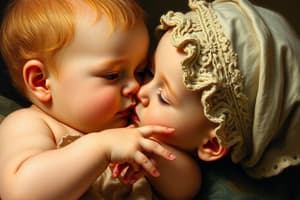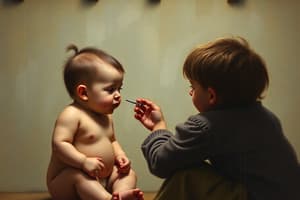Podcast
Questions and Answers
What is the average height of a 1-year-old at the end of the first year?
What is the average height of a 1-year-old at the end of the first year?
- 91.44 cm
- 75.44 cm
- 81.28 cm (correct)
- 71.28 cm
At what age do babies typically start to gain 'baby fat'?
At what age do babies typically start to gain 'baby fat'?
- 12 months
- 18 months
- 4 months
- 9 months (correct)
Which group tends to have greater physical maturity based on skeletal age?
Which group tends to have greater physical maturity based on skeletal age?
- Asian children
- Boys
- African-American children
- Girls (correct)
What is the typical weight of a 2-year-old?
What is the typical weight of a 2-year-old?
At what age can infants detect familiar objects represented by incomplete drawings even when most of the drawing is missing?
At what age can infants detect familiar objects represented by incomplete drawings even when most of the drawing is missing?
What do 2-month-old babies prefer when compared to other complex patterns?
What do 2-month-old babies prefer when compared to other complex patterns?
At what age can infants identify races and show preference for faces of their own race if they are mostly exposed to them?
At what age can infants identify races and show preference for faces of their own race if they are mostly exposed to them?
At what age can infants perceive emotional expressions on faces and discriminate positive emotions from negative emotions expressed by faces?
At what age can infants perceive emotional expressions on faces and discriminate positive emotions from negative emotions expressed by faces?
What is intermodal stimulation?
What is intermodal stimulation?
According to Gibsons’ Differentiation Theory, what do infants actively search for in the environment?
According to Gibsons’ Differentiation Theory, what do infants actively search for in the environment?
At what age can infants match faces with voices on the basis of lip-voice synchrony, emotional expression, age, and gender of the speaker?
At what age can infants match faces with voices on the basis of lip-voice synchrony, emotional expression, age, and gender of the speaker?
In classical conditioning, which of the following occurs naturally, without learning?
In classical conditioning, which of the following occurs naturally, without learning?
What results from learning in classical conditioning and elicits Conditioned Response (CR)?
What results from learning in classical conditioning and elicits Conditioned Response (CR)?
What refers to the gradual decrease in response to repeated stimulation, and is used to study infant memory and knowledge?
What refers to the gradual decrease in response to repeated stimulation, and is used to study infant memory and knowledge?
What involves infants acting on the environment, changing the probability of behavior?
What involves infants acting on the environment, changing the probability of behavior?
What occurs after habituation, when a new stimulus elicits a high response?
What occurs after habituation, when a new stimulus elicits a high response?
Which theory explains mastery of motor skills as acquiring increasingly complex systems of action?
Which theory explains mastery of motor skills as acquiring increasingly complex systems of action?
What skill involves control over larger movements in motor development?
What skill involves control over larger movements in motor development?
Which skill develops sequentially but not uniformly in motor development?
Which skill develops sequentially but not uniformly in motor development?
What refers to the ability of newborns to copy behaviors, rooted in mirror neuron system?
What refers to the ability of newborns to copy behaviors, rooted in mirror neuron system?
What decreases the probability of behavior in operant conditioning?
What decreases the probability of behavior in operant conditioning?
What measures recent memory and familiarity preference measures remote memory?
What measures recent memory and familiarity preference measures remote memory?
What impacts social relationships and cognitive capabilities?
What impacts social relationships and cognitive capabilities?
What is the cephalocaudal trend in human development?
What is the cephalocaudal trend in human development?
Which part of the body grows later than the head and trunk in the proximodistal trend?
Which part of the body grows later than the head and trunk in the proximodistal trend?
What are neurons responsible for during brain development?
What are neurons responsible for during brain development?
What is the function of glial cells in brain development?
What is the function of glial cells in brain development?
Which method is used to measure brain functioning milestones?
Which method is used to measure brain functioning milestones?
What accounts for 85% of the brain's weight?
What accounts for 85% of the brain's weight?
Which functions emerge later in prefrontal cortex development?
Which functions emerge later in prefrontal cortex development?
Which term describes the brain's capacity for learning and recovery from damage?
Which term describes the brain's capacity for learning and recovery from damage?
'Sensitive periods' in brain development refer to:
'Sensitive periods' in brain development refer to:
What is the concept of lateralization of the cerebral cortex?
What is the concept of lateralization of the cerebral cortex?
'Brain plasticity' refers to:
'Brain plasticity' refers to:
What does 'sensitive periods' in brain development imply?
What does 'sensitive periods' in brain development imply?
Which type of brain development refers to the ordinary experiences necessary for normal brain development?
Which type of brain development refers to the ordinary experiences necessary for normal brain development?
What is the additional growth and refinement of established brain structures due to specific learning experiences called?
What is the additional growth and refinement of established brain structures due to specific learning experiences called?
What leads to changes in sleep and wakefulness patterns in the first two years of life?
What leads to changes in sleep and wakefulness patterns in the first two years of life?
What promotes drowsiness at night in young children?
What promotes drowsiness at night in young children?
What influences physical growth, with identical twins being much alike in body size?
What influences physical growth, with identical twins being much alike in body size?
What is crucial for the first two years, providing the right kind of food for infant growth?
What is crucial for the first two years, providing the right kind of food for infant growth?
What can cause physical symptoms and lasting damage to the brain, heart, liver, and internal organs?
What can cause physical symptoms and lasting damage to the brain, heart, liver, and internal organs?
Which condition is caused by a diet low in all nutrients and results in a wasted condition of the body?
Which condition is caused by a diet low in all nutrients and results in a wasted condition of the body?
What are infants capable of shortly after birth, allowing them to learn by observation?
What are infants capable of shortly after birth, allowing them to learn by observation?
What is classical conditioning as a learning process where a neutral stimulus is paired with a stimulus that elicits a reflexive response known as?
What is classical conditioning as a learning process where a neutral stimulus is paired with a stimulus that elicits a reflexive response known as?
What form of learning allows infants to anticipate what is about to happen, making the world more predictable?
What form of learning allows infants to anticipate what is about to happen, making the world more predictable?
What do infants' perceptual development coincide with?
What do infants' perceptual development coincide with?
Which type of grasp is not part of reaching and grasping development in infants?
Which type of grasp is not part of reaching and grasping development in infants?
What does depth perception enhance in infants?
What does depth perception enhance in infants?
What do infants prefer looking at as their contrast sensitivity improves?
What do infants prefer looking at as their contrast sensitivity improves?
What is influenced by infants' experiences with depth perception, such as crawling?
What is influenced by infants' experiences with depth perception, such as crawling?
What do infants' visual abilities mature rapidly enabling them to focus on?
What do infants' visual abilities mature rapidly enabling them to focus on?
What does reaching and grasping play a significant role in for infant cognitive development?
What does reaching and grasping play a significant role in for infant cognitive development?
Which combination results in each new motor skill of an infant?
Which combination results in each new motor skill of an infant?
Which skill does not undergo major improvements from gross to fine movements in infant cognitive development?
Which skill does not undergo major improvements from gross to fine movements in infant cognitive development?
What does the mastery of ulnar, pincer, and manipulative grasps contribute to in infants?
What does the mastery of ulnar, pincer, and manipulative grasps contribute to in infants?
What enhances infants' awareness of the consequences of their movements?
What enhances infants' awareness of the consequences of their movements?
Which ability improves rapidly in infants enabling them to distinguish sounds and musical patterns?
Which ability improves rapidly in infants enabling them to distinguish sounds and musical patterns?
Flashcards are hidden until you start studying
Study Notes
-
The text discusses the impact of appropriate stimulation on brain development in young children.
-
Two types of brain development are identified: experience-expectant and experience-dependent.
-
Experience-expectant brain growth refers to ordinary experiences necessary for normal brain development, such as seeing and touching objects, hearing sounds.
-
Experience-dependent brain growth is the additional growth and refinement of established brain structures due to specific learning experiences.
-
For the first five or six years, there is no evidence of sensitive periods for changing states of arousal.
-
Rapid brain growth in the first two years leads to changes in sleep and wakefulness patterns, with a decline in fussiness and crying.
-
Sleep needs decline from 18 to 12 hours a day by age 2.
-
The sleep-wake pattern increasingly conforms to a night-day schedule, with the secretion of melatonin promoting drowsiness at night.
-
Influences on early growth include heredity and nutrition.
-
Heredity influences physical growth, with identical twins being much alike in body size.
-
Nutrition is crucial for the first two years, with breastfeeding providing the right kind of food for infant growth.
-
Malnutrition, particularly in developing countries and war-torn areas, can cause physical symptoms and lasting damage to the brain, heart, liver, and internal organs.
-
Malnutrition can be categorized as marasmus (wasted condition of the body caused by a diet low in all nutrients) and kwashiorkor (caused by an unbalanced diet very low in protein).
-
Affection and stimulation are necessary for healthy physical growth and vital as food.
-
Infants are capable of two forms of learning: classical conditioning and operant conditioning, as well as learning through natural preference for novel stimulation.
-
Shortly after birth, babies learn by observation (imitation).
-
Classical conditioning is a learning process where a neutral stimulus is paired with a stimulus that elicits a reflexive response.
-
With classical conditioning, infants can anticipate what is about to happen, making the world more predictable.
-
Motor skills develop as dynamic systems, where separate abilities blend together, enhancing each other. example: head and upper chest control lead to sitting.
-
Each new motor skill results from a combination of CNS development, body's movement capacity, child's goals, and environmental supports.
-
Reaching and grasping play a significant role in infant cognitive development and undergo major improvements from gross to fine movements.
-
Reaching and grasping development includes the mastery of ulnar, pincer, and manipulative grasps.
-
Infants' perceptual development, particularly in hearing and vision, coincides with motor skill development.
-
Infants' hearing abilities progress from distinguishing sounds and musical patterns to recognizing words in speech.
-
Infants' visual abilities mature rapidly, enabling them to focus on objects, recognize colors, and develop depth perception.
-
Depth perception is influenced by sensitivity to various motion and visual cues and enhances infants' awareness of the consequences of their movements.
-
Infants prefer looking at complex patterns as their contrast sensitivity improves, indicating their growing visual abilities.
-
Infants' experiences with depth perception, such as crawling, contribute to their understanding of the world and their own physical abilities.
-
Infants' preference for complex patterns, as indicated by Contrast Sensitivity, reflects their growing ability to distinguish fine features in visual stimuli.
Studying That Suits You
Use AI to generate personalized quizzes and flashcards to suit your learning preferences.




